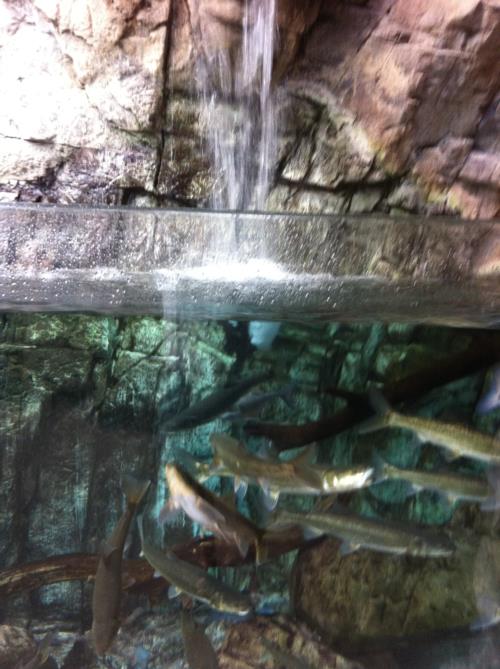 In which Diver Dave finds himself between a rock and a hard place. Part 4 of Several Installments.
In which Diver Dave finds himself between a rock and a hard place. Part 4 of Several Installments.Diving in the Pathway exhibits is very different– they’re very shallow (no more than 7 or 8 feet deep) and very narrow, much too narrow for standard scuba gear, so we have to use a ‘hookah’ system: two tanks mounted on a cart, with about a hundred feet of hose leading to our regulators. After positioning the cart so that we can see the air pressure gauges thru the windows, we climb over the acrylic walls into the exhibit, and have to be very careful not to step on or pin any of the fish. The water tends to be much colder than in the larger tanks as well, so some divers use a dry-suit; I have to settle for a thick (7mm) wetsuit until I get dry-suit certified.
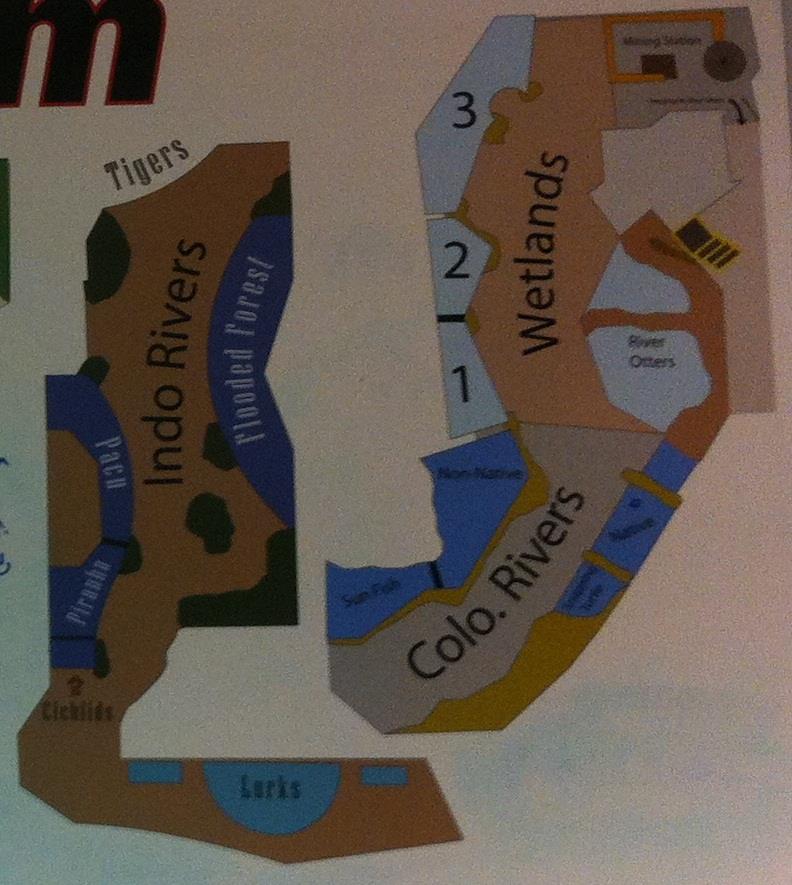
Of course, the fish are characters themselves. Some are very skittish: the Arrowanas have been known to jump out of the tank when they get panicked or cornered. Then there’s the fish that are so comfortable with us that, once we’re laying prone in the tank doing whatever we have to do, they have no issue with using our legs or back as a resting surface. One time I tried to adjust my mask and couldn’t quite get my arm around. I thought I’d snagged it on the siphon hose, but when I looked I saw that I was hugging a catfish that had decided that hanging off my shoulder and supervising my work was fascinating. She just looked at me with an expression of, “So, I expect at least dinner before we take this to the next level!”
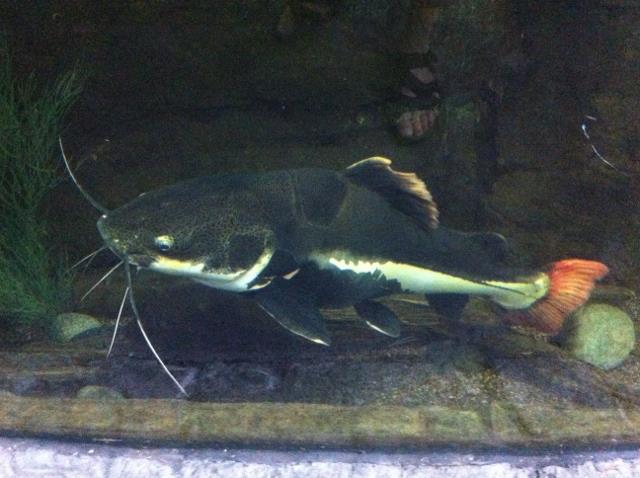
Diving in the River Otters tank is very rare - the water quality is often such that nobody can dive it without a HazMat suit. There’s no human/otter interaction permitted, and the pools are small, so it’s not that big a deal.
River work is mostly a matter of scrubbing the surfaces, siphoning, and re-planting and positioning the fake plants and real rocks. But there’re logs and boulders to maneuver around and sometimes it’s just a matter of jamming my feet and hanging upside down so I can hold a position as I work. And with two divers dragging long lines of regulator hose, we have to be careful not to get tangled up in anything or each other. But perhaps the weirdest thing is looking out from the bottom of a 7 foot deep tank and seeing a kid from a school group with his face pressed up against the glass, staring at me as though I’m part of the exhibit myself!
The various logs get awfully furry with growth; you know you’ve done a good job of scrubbing when you suddenly find yourself in a near black-out condition in the tank. During one my stints I literally couldn’t see my fins at one point, the visibility got so bad. The water circulation is so good, though, that by the time we got out the water was almost perfectly clear again.
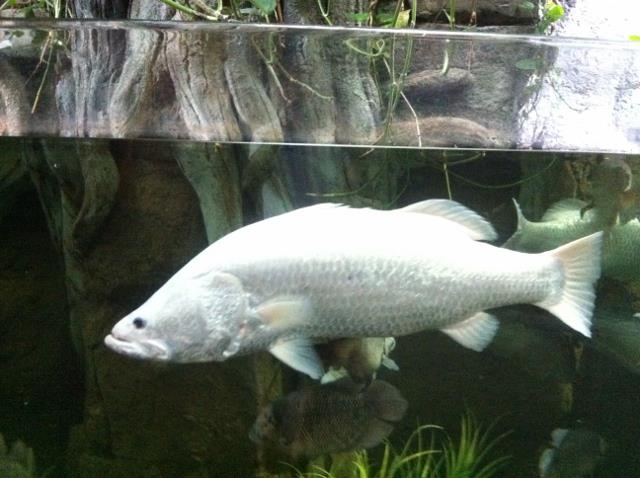
Wetlands is very similar to the Colorado and Indonesia River exhibits, but geez, is it COLD! Around 50 degrees Fahrenheit; I wore a 7mm wetsuit that I borrowed from the Aquarium’s volunteers rack, along with my usual 5mm gloves and boots, and while I probably could have gone another 15 minutes, I wasn’t too upset when my instructor called the dive at 10:10 as guests began walking thru. One of the nice things about siphoning in these smaller exhibits is that it’s so easy to see the progress being made – it’s very satisfying to see huge masses of detritus being sucked up and out of the tank. Unfortunately there wasn’t a lot of interaction with the wildlife; although there were plenty of trout and other fish, they all kept their distance as I siphoned around the rocks and plants.
Lurks, or ‘Under the Boardwalk,’ is a very shallow tank – it’s only about 3.5’ – 4’ deep. Despite its depth, it’s one of the most challenging exhibits to dive in. It displays an environment similar to what would be found under a typical Southern California wharf: kelp, pilings w/ barnacles, lobster and crab traps, shells, sand and rocks.
The tank is raised up about 3’ off the floor – there are three acrylic domes built into the floor of the exhibit, so guests can duck under and get a flounder’s eye view. The pilings that imitate the wharf’s support are covered in (fake) barnacles that are just as sharp as the real thing, and a couple of them are placed very close to the viewing window. The plants and mollusks are fake, of course, but the water is a cool 48 degrees. Since I grew up diving in SoCal it wasn’t a total surprise, but I’m glad I had a 7mm wetsuit. There are several types of small sharks, a bright electric-blue Wolf Eel, cod and skates, and even a flounder or two.
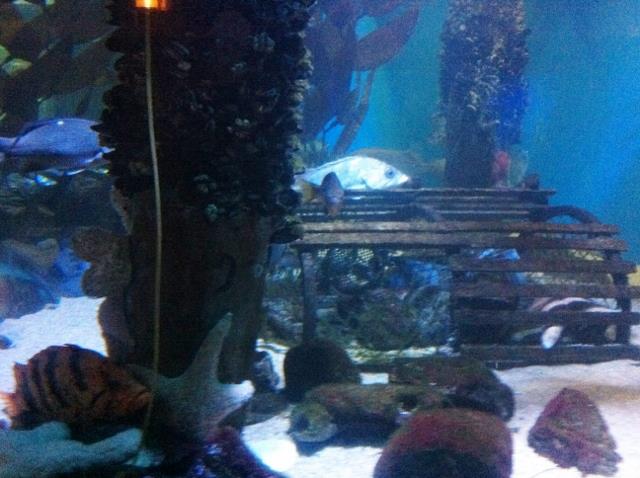
In keeping with the dock-side theme, there’s a wooden wharf-like structure over the general area, complete with ropes and netting hanging down, as well as tackle boxes. The structure casts a shadow over the exhibit, which is appropriate for the setting, but makes seeing the schmutz a bit tough.
Getting in and out is a real challenge – a 10 foot ladder is needed to get to the top of the wharf. The ladder is set up on the pathway, so this is a morning-only dive – because it’s so narrow we have to be done and out of the area before guests arrive. There’s a trap-door over one corner of the tank, but the surface of the water is still some 2 feet below the wharf. There’s a narrow ledge just above the water on which to perch before dropping into the water, but the scrubbing tools need to be placed there before entering. As if that’s not enough of a challenge, there’s a tiny opening that leads from the ledge to behind the tank, between the surface of the ledge and the bottom of the wharf. One wrong move and you can push your scrubbing tools behind the tank, requiring a trek down the ladder and thru a hidden door; this leads to a tiny corridor full of the life-support pipes for the exhibit. Kick one too hard and you can cause no end of trouble for the Aquarists and Facility folks. And of course to avoid losing control while entering the water, weight belts are left off until we’re standing in the water itself, so that’s something else that has to be on the ledge.
With such a narrow tank to work in, Hookahs are required – scuba gear would be impossible to maneuver with. We thread the hoses and regulators through a narrow gap between the top of the tank and the bottom of the wharf. Then we haul the rest of our gear, mainly weights, up to the top of the wharf, carefully stepping around ropes, nets, lines, and so on. The only thing missing is seagull poop on the pilings and wood.
One of the acrylic domes is positioned so that it intrudes into the space directly under the trap-door about one-third of the way, reducing the amount of surface to stand on. On my dive, there were a couple of pajama sharks
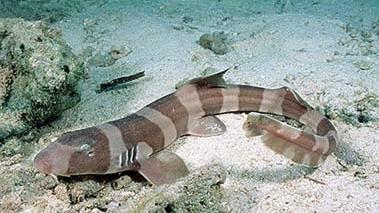
and a ling cod that were also resting in the area, so my landing zone was about the size of a nickel. I had to lower myself very slowly into the water, and gently nudge the cod out of the way. Once I was in the water I found that there was only about 6” of space between the surface of the water and the bottom of the wharf. No place for claustrophobics, and as close to an ‘overhead’ environment that I want to be in without the attraction of a cave or wreck.
Michelle H was my trainer for this dive: a small (115#) lady who carried nearly 40% of her body weight in a dry-suit weight harness, because of all of the neoprene she wore. I needed an extra 14 lbs (I usually only need about 22 lbs) of weight myself to stay down comfortably – I ended up using a second weight belt slung over my shoulder like a bandolier.
No feeding in this tank – just a lot of scrubbing and window wiping. My left arm began to get sore from holding on to the suction cup to help me move along the viewing window. Squeezing between the window and pilings (it was easier than trying to maneuver over and around the other obstacles) was easier than I expected, though I nearly dropped a knee on a starfish on the way out, and almost pinned a flounder on the way back in. The kelp needed a lot of scrubbing, and it was far more difficult than doing the faux coral in the other exhibits.
Dave Madorsky lives in the Denver Metropolitan Area; his personal philosophy is, “Anytime I’m underwater and still breathing is a GOOD time!”Disclaimer: Most pictures were taken by Dave Madorsky and are copyright protected, but some are from public domain sources to better illustrate the sea life described.